A Power Evolution Game Model and Its Application Contained in Virtual Power Plants
Abstract
1. Introduction
2. Literature Review
2.1. Demand Response
2.2. Game Research in Power Systems
3. Modeling Approach
3.1. Basic Description and Modeling Settings
3.1.1. Basic Description
- (1)
- Government departments. In order to promote the demand-side reform of the power system, the government has active management and negative management strategies. To promote the demand-side reform, the government provides subsidies to the power companies actively participating in the demand-side reform and the participating VPPs who choose to dynamically adjust the electricity price, and at the same time spends relevant costs to supervise the power behaviour of the power companies and VPPs. Promoting power demand-side reform can save power resources, rationally adjust industrial structure, optimise resource allocation, improve and protect the environment, effectively raise social and environmental benefits and enhance the credibility of the government. The set of government’s behavioural strategies is {Active management , Negative management }, and their selection probabilities are { and }, respectively.
- (2)
- Power companies. Positive participation in the demand-side reform can reduce the pressure on the power company, improve the stability of the power system, and ensure the stability of the market electricity price. The reform of the demand side can effectively reduce the pressure on the supply side of the grid company, transfer some risks to VPPs and obtain more power regulation autonomy and reduce the restrictions of the power generation company. Power grid companies actively participate in demand-side reform, and can dynamically adjust electricity consumption at any time, adjust different prices according to different periods of electricity use, and save power costs. The power companies’ actions include optimising electricity purchasing patterns, implementing different electricity prices and guiding and assisting VPPs to understand effective dynamic electricity consumption behaviours. The demand-side reform behaviour of power companies can obtain corporate reputation, reduce the risk of price fluctuation in the electricity market and obtain additional income utility. Take power companies’ behavioural strategies as {Positive participation , Passive participation } and their probabilities as { and }.
- (3)
- VPPs. VPPs can choose to actively participate in or passively resist demand-side reform. If VPPs choose to actively participate and adjust their electricity consumption according to the peak electricity consumption in the electricity market, it will bring a certain impact on their personal lives and affect the convenience of VPPs. However, the active participation of VPPs will save VPP electricity costs, and bring more social benefits and economic value. Take VPP’s behavioural strategies as {Participation , Nonparticipation } with probabilities as { and }.
3.1.2. Modeling Settings
3.2. A Dynamic Replication Equation for a Three-Part Evolutionary Game
3.3. Evolutionary Games’ Stability Analysis
3.3.1. Government’s Stability Analysis
- (1)
- When , that is , then , remains unchanged. As shown in Figure 3a, the government has been in a relatively stable strategic position.
- (2)
- When , that is , we obtain . When , , the presence of stability is and . If , . At this point, 1 is ESS, as shown in Figure 3b. At this point, the government will be inclined to take unregulated measures due to the high cost of managing electricity demand-side reforms.
- (3)
- When , , that is . If , and are the two stable points. If , , at this point is ESS and the government takes an active management attitude in order to maximise the benefits. Since there exists , that is , , then is ESS, and conversely, is ESS. This indicates that, as gradually increases government’s stabilisation strategy will shift from active to passive regulation.
- (4)
- The probability of positive government behaviour for demand-side reform in Figure 3(b1,b2) is and negative management behaviour is , where , and the presence of means that the probability of positive government behaviour for demand-side reform is negatively related to and and positively related to . This suggests that the motivation of government departments to proactively engage in demand-side reform in the electricity sector can be promoted at this time by increasing the government’s cost of reducing government management efforts , reducing the amount of subsidies to power companies and increasing the benefits of punitive measures .
3.3.2. Power Companies’ Stability Analysis
- (1)
- If , that is , and , remain constant. Figure 4a indicates that the power company is at a relatively stable state.
- (2)
- If , , there is . When , we can obtain and . If , , then is ESS. Figure 4b indicates that the benefits of demand-side reform by the power company are less than the costs, and tend to participate negatively.
- (3)
- If , , there is . When , we can obtain and . If , , then is ESS. Figure 4b indicates that the demand-side reform of the power company brings additional benefits, and the power company is in an active participation state. If , and , the ESS are and . Therefore, with the gradual increase of 5, the behavioural strategy of grid company’s demand-side reform shifts from active to passive, and the probability of the power companies’ demand-side reform behaviour gradually decreases with the active government and consumer demand-side reform.
- (4)
- As can be seen in Figure 4(b1,b2), the probability of the grid companies’ active participation in demand-side reform can be expressed as ; the probability of power companies’ negative participation in demand reform is , where , , exists , which indicates that by reducing the cost of power companies choosing demand-side reform , government incentives for power companies active demand-side reform , and the increase in opportunity cost all increase the power companies’ active demand-side-reform probability.
3.3.3. VPP’s Stability Analysis
- (1)
- If , then , remains unchanged. Figure 5a indicates that the VPPs are in a stable situation.
- (2)
- If , then . If , then and . If , , then . Figure 5b indicates that, the benefits obtained by VPPs actively participating in the demand-side reform of electricity are smaller than the costs, and they are in a state of reluctance to participate in the electricity demand-side reform.
- (3)
- If , there is . If , there are and . If , , there is . Figure 5b indicates that VPPs gain additional benefits by participating in the electricity demand-side reform behaviour, and VPPs are in the state of active participation behaviour.
- (4)
- In Figure 5(b1,b2), the probability of VPP’s electricity demand-side reform is , , where , , and . VPP’s motivation can be increased by reducing the cost of participation in VPP’s electricity demand-side reform behaviour .
3.3.4. Power Systems’ Stability Analysis
- (1)
- Scenario 1:
- (2)
- Scenario 2:
4. Numerical Simulation
4.1. Initial Strategy Dynamic Evolutionary Trajectory
4.2. Effect Analyses of Different Parameters on Power System Dynamics
4.2.1. Impact of Parameter
4.2.2. Impact of Parameters and
4.2.3. Impact of Power Company Costs
4.2.4. Impact of VPP Costs
5. Conclusions and Recommendations
5.1. Conclusions
- (1)
- As the leader of the industry development, government plays a key role for demand-side reform of power industry. Government, as a policy maker and executor, actively promotes the demand-side reform of power system, will encourage the initiative consciousness of power companies and VPPs. The management cost of government demand-side reform (), subsidies to power companies (), punitive measures () and subsidies to VPPs () will all have a significant impact on the behavioural orientation of the power system. The government should give full play to the key role of policy makers and promoters, improve the supervision, reward and punishment and dynamic feedback mechanism of demand-side reform and promote the effective completion of demand-side reform.
- (2)
- Power companies and VPPs will influence and assist each other as a consortium of interests. When power companies actively implement demand-side response, it needs to fully consider the acceptance degree and convenience of VPPs, so as to cooperate with VPPs to complete the demand-side response with better information sharing. By cooperating with power companies, VPPs can achieve energy saving and environmental protection behaviours at a lower cost, relieve the inconvenience caused by electricity shortage and realise coordinated energy saving development.
- (3)
- The demand-side response behaviours of power companies and VPPs are mainly influenced by benefit and cost factors. Lower demand-side response costs () and increased opportunity costs will increase the incentive for power companies on demand-side response. A reduction in the cost of VPPs () and an increase in the government subsidies () will increase the incentive for consumer demand-side response. Therefore, the government should reduce the costs of demand-side response for both utilities and VPPs in a multi-channel manner to help them gain more economic benefits.
5.2. Recommendations
- (1)
- Government’s active management measures can effectively promote the demand-side reform of power system. Starting with the long-term development objectives of energy conservation and environmental protection, the government should set up a solid legal and regulatory framework to actively support and promote the demand-side reform of the power system, and guarantee power conservation during various times of the day with various peaks. Government guidance can enhance the awareness of social responsibility of power companies and VPPs to a certain extent, and promote their enthusiasm to participate in the demand-side reform of power system. However, it is worth noting that government needs to pay attention and take measures to reduce supervision and management cost due to the limitation of fiscal revenue. Therefore, government can explore multi-channel financing methods, establish market trading platform for power system, introduce financial market regulation and other methods to control the cost and ensure the continuity and initiative of government regulation.
- (2)
- An efficient incentive and punishment system should be put into place. According to research findings, the government may successfully promote the demand-side reform by enacting reward and punishment policies. Lower fines or, simply, incentives will have an impact on the demand side of the power companies and VPPs. Therefore, government should improve the reward and punishment mechanism, establish a supervision and feedback mechanism and take cooperative measures in various ways to manage the behaviour of power companies and VPPs. The demand-side reform of the power system requires a large amount of construction costs, and there are some problems such as long construction cycle, slow benefit recovery that affect the normal pace of life of VPPs. Therefore, reform compensation should be given to ease the cost input of power companies and compensate VPPs for the convenience of life. In order to limit the behaviour of power companies and VPPs, punitive measures will be applied to those that break the rules, such as fines, suspension of activities, or platform notification. With the dynamic behaviour adjustment of all participants during the demand-side response, government needs to adjust the policy direction and change the electric price in the electricity price market timely. In this way, the demand-side reform of the power industry can be monitored dynamically in real time, the cost of government regulation can be reduced and the development direction of effective environmental protection of the power industry can be promoted.
- (3)
- The demand-side reform of the power industry needs the coordinated promotion of power companies and VPPs. Power companies must begin with the industrial layout, fully utilise the benefits of their power system platform and optimise the allocation of power resources based on peak power consumption and regional power consumption characteristics. Power companies should dynamically adjust equipment level load storage capacity, improve the flexibility of power load, adopt “unified control + flexible regulation” and other means to ensure the orderly storage and use of power. At the same time, power companies should rely on the response compensation policy, take measures such as the implementation of residential air conditioning push invitation, independent flexible adjustment, through the market mechanism to quickly complete the effective aggregation of resources and local balance, to realise the “peak error + drainage” regulation of charging load spatial and temporal distribution, to ensure that the “every degree of electricity should be controlled and adjusted”.
- (4)
- For VPPs, in order to avoid adverse effects on their lives brought by extreme weather and power supply shortage, they should actively cooperate with the demand-side reform of power companies, respond to national policy guidance, dynamically adjust the power consumption limit and actively respond and participate in the demand response such as peak regulation and frequency regulation of the system. Responding to the dynamic trend of marketisation can help VPPs save money on electricity costs while also enhancing their own reputation in society. On the one hand, through the compensation of electricity technology and the convenience of electricity technology, nations and businesses can entice consumers’ demand-side electricity behaviour. On the other hand, demand-response certificates, credit scores and the development of energy credit ratings can all be used to promote and accelerate VPP demand-side reform.
Author Contributions
Funding
Data Availability Statement
Conflicts of Interest
References
- United Nations. Paris Agreement. Available online: https://unfccc.int/sites/default/files/english_paris_agreement.pdf (accessed on 15 July 2022).
- IRENA Global Energy Transformation: A Roadmap to 2050. Available online: https://www.irena.org/publications/2019/Apr/Global-energy-transformation-A-roadmap-to-2050-2019Edition (accessed on 26 November 2020).
- Commission, E. Climate & Energy Framework—Climate Action. 2030 Climate & Energy Framework. 2019. Available online: https://ec.europa.eu/clima/policies/strategies/2030_en (accessed on 10 July 2022).
- Escoffier, M.; Hache, E.; Mignon, V.; Paris, A. Determinants of solar photovoltaic deployment in the electricity mix: Do oil prices really matter? Energy Econ. 2021, 97, 105024. [Google Scholar] [CrossRef]
- Fragkos, P.; van Soest, H.L.; Schaeffer, R.; Reedman, L.; Köberle, A.C.; Macaluso, N.; Evangelopoulou, S.; De Vita, A.; Sha, F.; Qimin, C.; et al. Energy system transitions and low-carbon pathways in Australia, Brazil, Canada, China, EU-28, India, Indonesia, Japan, Republic of Korea, Russia and the United States. Energy 2021, 216, 119385. [Google Scholar] [CrossRef]
- Delucchi, M.A.; Jacobson, M.Z. Providing all global energy with wind, water, and solar power, Part II: Reliability, system and transmission costs, and policies. Energy Policy 2011, 39, 1170–1190. [Google Scholar] [CrossRef]
- Shakouri, H.G. The share of cooling electricity in global warming: Estimation of the loop gain for the positive feedback. Energy 2019, 179, 747–761. [Google Scholar] [CrossRef]
- Lacroix, K.; Gifford, R. Psychological Barriers to Energy Conservation Behavior: The Role of Worldviews and Climate Change Risk Perception. Environ. Behav. 2018, 50, 749–780. [Google Scholar] [CrossRef]
- Awasthi, A.; Shukla, A.K.; Manohar, M.S.R.; Dondariya, C.; Shukla, K.N.; Porwal, D.; Richhariya, G. Review on sun tracking technology in solar PV system. Energy Rep. 2020, 6, 392–405. [Google Scholar] [CrossRef]
- de Paulo, A.F.; Porto, G.S. Evolution of collaborative networks of solar energy applied technologies. J. Clean. Prod. 2018, 204, 310–320. [Google Scholar] [CrossRef]
- Bird, L.; Lew, D.; Milligan, M.; Carlini, E.M.; Estanqueiro, A.; Flynn, D.; Gomez-Lazaro, E.; Holttinen, H.; Menemenlis, N.; Orths, A.; et al. Wind and solar energy curtailment: A review of international experience. Renew. Sustain. Energy Rev. 2016, 65, 577–586. [Google Scholar] [CrossRef]
- Joos, M.; Staffell, I. Short-term integration costs of variable renewable energy: Wind curtailment and balancing in Britain and Germany. Renew. Sustain. Energy Rev. 2018, 86, 45–65. [Google Scholar] [CrossRef]
- CPC (the Central Committee of the Communist Party of China) and the State Council. Opinions Regarding Further Deepening of the Power Sector Reform. 2015. Available online: http://www.ne21.com/news/show-64828.html (accessed on 15 March 2015).
- NDRC (National Development and Reform Commission). Interpretation of Power Sector Reform; People’s Publishing House: Beijing, China; pp. 1–40. Available online: http://drc.gd.gov.cn/snyj/bmgl/content/post_3736970.html (accessed on 19 April 2023).
- Pozo, D.; Sauma, E.E.; Contreras, J. A Three-Level Static MILP Model for Generation and Transmission Expansion Planning. IEEE Trans Power Syst. 2013, 28, 202–210. [Google Scholar] [CrossRef]
- Guelpa, E.; Verda, V. Demand response and other demand side management techniques for district heating: A review. Energy 2021, 219, 119440. [Google Scholar] [CrossRef]
- Stanelyte, D.; Radziukyniene, N.; Radziukynas, V. Overview of Demand-Response Services: A Review. Energies 2022, 15, 1659. [Google Scholar] [CrossRef]
- Yu, J.; Liu, J.; Wen, Y.; Yu, X. Economic Optimal Coordinated Dispatch of Power for Community Users Considering Shared Energy Storage and Demand Response under Blockchain. Sustainability 2023, 15, 6620. [Google Scholar] [CrossRef]
- Gupta, P.; Verma, Y.P. Voltage profile improvement using demand side management in distribution networks under frequency linked pricing regime. Appl. Energy 2021, 295, 117053. [Google Scholar] [CrossRef]
- Soder, L.; Lund, P.D.; Koduvere, H.; Bolkesjo, T.F.; Rossebo, G.H.; Rosenlund-Soysal, E.; Skytte, K.; Katz, J.; Blumberga, D. A review of demand side flexibility potential in Northern Europe. Renew. Sustain. Energy Rev. 2018, 91, 654–664. [Google Scholar] [CrossRef]
- Hoicka, C.E.; Lowitzsch, J.; Brisbois, M.C.; Kumar, A.; Camargo, L.R. Implementing a just renewable energy transition: Policy advice for transposing the new European rules for renewable energy communities. Energy Policy 2021, 156, 112435. [Google Scholar] [CrossRef]
- Annala, S.; Lukkarinen, J.; Primmer, E.; Honkapuro, S.; Ollikka, K.; Sunila, K.; Ahonen, T. Regulation as an enabler of demand response in electricity markets and power systems. J. Clean. Prod. 2018, 195, 1139–1148. [Google Scholar] [CrossRef]
- Cardoso, C.A.; Torriti, J.; Lorincz, M. Making demand side response happen: A review of barriers in commercial and public organisations. Energy Res. Soc. Sci. 2020, 64, 101443. [Google Scholar] [CrossRef]
- Pozo, D.; Contreras, J.; Sauma, E. If you build it, he will come: Anticipative power transmission planning. Energy Econ. 2013, 36, 135–146. [Google Scholar] [CrossRef]
- Huppmann, D.; Egerer, J. National-strategic investment in European power transmission capacity. Eur. J. Oper. Res. 2015, 247, 191–203. [Google Scholar] [CrossRef]
- Bergaentzle, C.; Clastres, C.; Khalfallah, H. Demand-side management and European environmental and energy goals: An optimal complementary approach. Energy Policy 2014, 67, 858–869. [Google Scholar] [CrossRef]
- Algarvio, H.; Lopes, F. Bilateral Contracting and Price-Based Demand Response in Multi-Agent Electricity Markets: A Study on Time-of-Use Tariffs. Energies 2023, 16, 645. [Google Scholar] [CrossRef]
- Voulis, N.; van Etten, M.J.J.; Chappin, E.J.L.; Warnier, M.; Brazier, F.M.T. Rethinking European energy taxation to incentivise consumer demand response participation. Energy Policy 2019, 124, 156–168. [Google Scholar] [CrossRef]
- Chen, L.; Yang, Y.; Xu, Q. Retail dynamic pricing strategy design considering the fluctuations in day-ahead market using integrated demand response. Int. J. Electr. Power Energy Syst. 2021, 130, 106983. [Google Scholar] [CrossRef]
- Liu, J.; Sun, J.; Yuan, H.; Su, Y.; Feng, S.; Lu, C. Behavior analysis of photovoltaic-storage-use value chain game evolution in blockchain environment. Energy 2022, 260, 125182. [Google Scholar] [CrossRef]
- Warren, P. Demand-Side Policy: Mechanisms for Success and Failure. Econ. Energy Environ. Policy 2019, 8, 119–144. [Google Scholar] [CrossRef]
- Shen, B.; Ghatikar, G.; Lei, Z.; Li, J.; Wikler, G.; Martin, P. The role of regulatory reforms, market changes, and technology development to make demand response a viable resource in meeting energy challenges. Appl. Energy 2014, 130, 814–823. [Google Scholar] [CrossRef]
- Gils, H.C. Economic potential for future demand response in Germany—Modeling approach and case. Appl. Energy 2016, 162, 401–415. [Google Scholar] [CrossRef]
- Walawalkar, R.; Fernands, S.; Thakur, N.; Chevva, K.R. Evolution and current status of demand response (DR) in electricity markets: Insights from PJM and NYISO. Energy 2010, 35, 1553–1560. [Google Scholar] [CrossRef]
- Li, W.; Xu, P.; Lu, X.; Wang, H.; Pang, Z. Electricity demand response in China: Status, feasible market schemes and pilots. Energy 2016, 114, 981–994. [Google Scholar] [CrossRef]
- Zeng, M.; Li, C.; Chen, Y.J.; Xu, W.X. Implementation mode of power demand side response to large-scale wind power integrated grid in China. East China Electr. 2012, 40, 363–367. [Google Scholar]
- de Christo, T.M.; Perron, S.; Fardin, J.F.; Lyrio Simonetti, D.S.; de Alvarez, C.E. Demand-side energy management by cooperative combination of plans: A multi-objective method applicable to isolated communities. Appl. Energy 2019, 240, 453–472. [Google Scholar] [CrossRef]
- Churkin, A.; Bialek, J.; Pozo, D.; Sauma, E.; Korgin, N. Review of Cooperative Game Theory applications in power system expansion planning. Renew. Sustain. Energy Rev. 2021, 145, 111056. [Google Scholar] [CrossRef]
- Ganguly, S.; Sahoo, N.C.; Das, D. Mono- and multi-objective planning of electrical distribution networks using particle swarm optimization. Appl. Soft Comput. 2011, 11, 2391–2405. [Google Scholar] [CrossRef]
- Tsukamoto, Y.; Iyoda, I. Allocation of fixed transmission cost to wheeling transactions by cooperative game theory. IEEE Trans Power Syst. 1996, 11, 620–627. [Google Scholar] [CrossRef]
- Gately, D. Sharing the gains from regional cooperation: A game theoretic application to planning investment in electric power. Int. Econ. Rev. 1974, 15, 195–208. [Google Scholar] [CrossRef]
- Zolezzi, J.M.; Rudnick, H. Transmission cost allocation by cooperative games and coalition formation. IEEE Trans Power Syst. 2002, 17, 1008–1015. [Google Scholar] [CrossRef]
- Chattopadhyay, D. An energy brokerage system with emission trading and allocation of cost savings. IEEE Trans Power Syst. 1995, 10, 1939–1945. [Google Scholar] [CrossRef] [PubMed]
- Beltadze, G.N. Foundations of Lexicographic Cooperative Game Theory. IJMECS 2013, 5, 18–25. [Google Scholar] [CrossRef]
- Dey, S. Securing Majority-Attack in Blockchain Using Machine Learning and Algorithmic Game Theory: A Proof of Work. In Proceedings of the 2018 10th Computer Science and Electronic Engineering Conference (CEEC) 2018, Colchester, UK, 19–21 September 2018; pp. 7–10. [Google Scholar]
- Ogidiaka, E.; Ogwueleka, F.N.; Irhebhude, M.E. Game-Theoretic Resource Allocation Algorithms for Device-to-Device Communications in Fifth Generation Cellular Networks: A Review. Int. J. Inf. Eng. Electron. Bus. 2021, 3, 44–51. [Google Scholar] [CrossRef]
- Pitchai, A.; Reddy, A.V.; Savarimuthu, N. Quantum Walk Algorithm to Compute Subgame Perfect Equilibrium in Finite Two-player Sequential Games. Int. J. Math. Sci. Comput. 2016, 2, 32–40. [Google Scholar] [CrossRef]
- Dalkani, H.; Mojarad, M.; Arfaeinia, H. Modelling Electricity Consumption Forecasting Using the Markov Process and Hybrid Features Selection. Int. J. Intell. Syst. Appl. 2021, 13, 14–23. [Google Scholar] [CrossRef]
- Contreras, J.; Klusch, M.; Krawczyk, J.B. Numerical solutions to Nash-Cournot equilibria in coupled constraint electricity markets. IEEE Trans Power Syst. 2004, 19, 195–206. [Google Scholar] [CrossRef]
- Pozo, D.; Contreras, J. Finding Multiple Nash Equilibria in Pool-Based Markets: A Stochastic EPEC Approach. IEEE Trans Power Syst. 2011, 26, 1744–1752. [Google Scholar] [CrossRef]
- Huppmann, D.; Siddiqui, S. An exact solution method for binary equilibrium problems with compensation and the power market uplift problem. Eur. J. Oper. Res. 2018, 266, 622–638. [Google Scholar] [CrossRef]
- Sauma, E.E.; Oren, S.S. Proactive planning and valuation of transmission investments in restructured electricity markets. J. Regul. Econ. 2006, 30, 261–290. [Google Scholar] [CrossRef]
- Taheri, S.S.; Kazempour, J.; Seyedshenava, S. Transmission expansion in an oligopoly considering generation investment equilibrium. Energy Econ. 2017, 64, 55–62. [Google Scholar] [CrossRef]
- Kasina, S.; Hobbs, B.F. The value of cooperation in interregional transmission planning: A noncooperative equilibrium model approach. Eur. J. Oper. Res. 2020, 285, 740–752. [Google Scholar] [CrossRef]
- Hobbs, B.F.; Kelly, K.A. Using game theory to analyze electric transmission pricing policies in the United States. Eur. J. Oper. Res. 1992, 56, 154–171. [Google Scholar] [CrossRef]
- Du, Y.; Wang, Z.; Liu, G.; Chen, X.; Yuan, H.; Wei, Y.; Li, F. A cooperative game approach for coordinating multi-microgrid operation within distribution systems. Appl. Energy 2018, 222, 383–395. [Google Scholar] [CrossRef]
- Contreras, J. A Cooperative Game Theory Approach to Transmission Planning in Power Systems. Ph.D. Thesis, University of California, Berkeley, CA, USA, 1997. [Google Scholar]
- Geerli, L.; Chen, L.; Yokoyama, R. Pricing and operation in deregulated electricity market by noncooperative game. Electr. Power Syst. Res. 2001, 57, 133–139. [Google Scholar] [CrossRef]
- Hariyanto, N.; Nurdin, M.; Haroen, Y.; Machbub, C. Decentralized And Simultaneous Generation and Transmission Expansion Planning Through Cooperative Game Theory. Int. J. Electr. Eng. Inf. 2009, 1, 149–164. [Google Scholar] [CrossRef]
- Serrano, R.; Zolezzi, J.; Rudnick, H.; Araneda, J.C. Transmission expansion in the Chilean system via cooperative game theory. In Proceedings of the 2005 IEEE Russia Power Tech, St. Petersburg, Russia, 27–30 June 2005; pp. 1–6. [Google Scholar] [CrossRef]
- Hewitt, C.G.; Wainwright, J. A dynamical systems approach to Bianchi cosmologies: Orthogonal models of class B. Class. Quantum Gravity 1993, 10, 99. [Google Scholar] [CrossRef]
- Smith, M.C. The general problem of the stability of motion: Translated and Edited by A. T. Fuller. Taylor and Francis, 1992. Automatica 1995, 31, 353–354. [Google Scholar] [CrossRef]
- Friedman, D. Evolutionary Games in Economics. Econometrica 1991, 59, 637–666. [Google Scholar] [CrossRef]
- Smith, J.M. Evolution and the theory of games. Am. Sci. 1976, 64, 41–45. [Google Scholar] [PubMed]
- Allen, B.; Lippner, G.; Chen, Y.-T.; Fotouhi, B.; Momeni, N.; Yau, S.-T.; Nowak, M.A. Evolutionary dynamics on any population structure. Nature 2017, 544, 227. [Google Scholar] [CrossRef]
- Fan, G.-F.; Peng, L.-L.; Hong, W.-C. Short-term load forecasting based on empirical wavelet transform and random forest. Electr. Eng. 2022, 104, 4433–4449. [Google Scholar] [CrossRef]
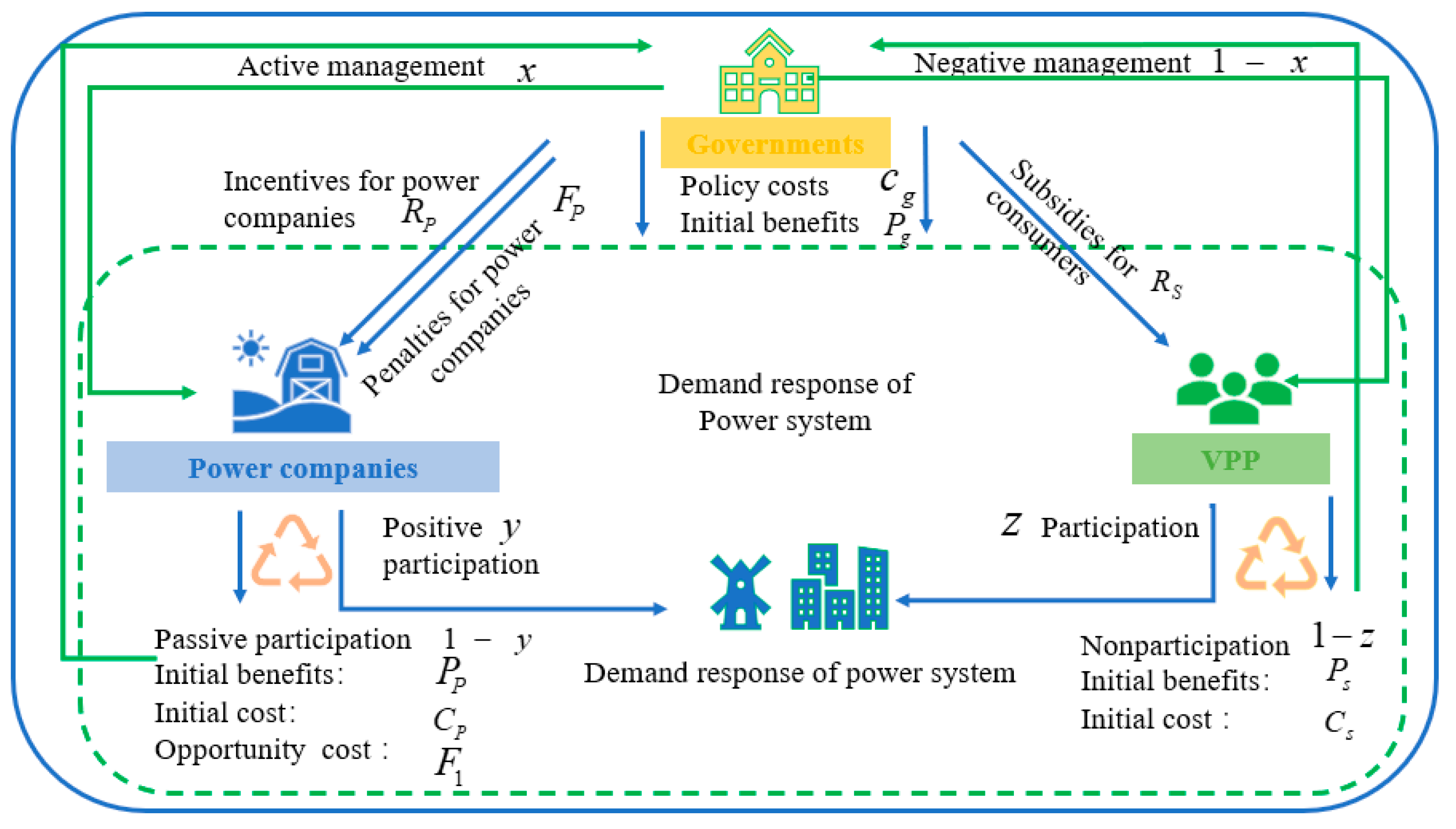
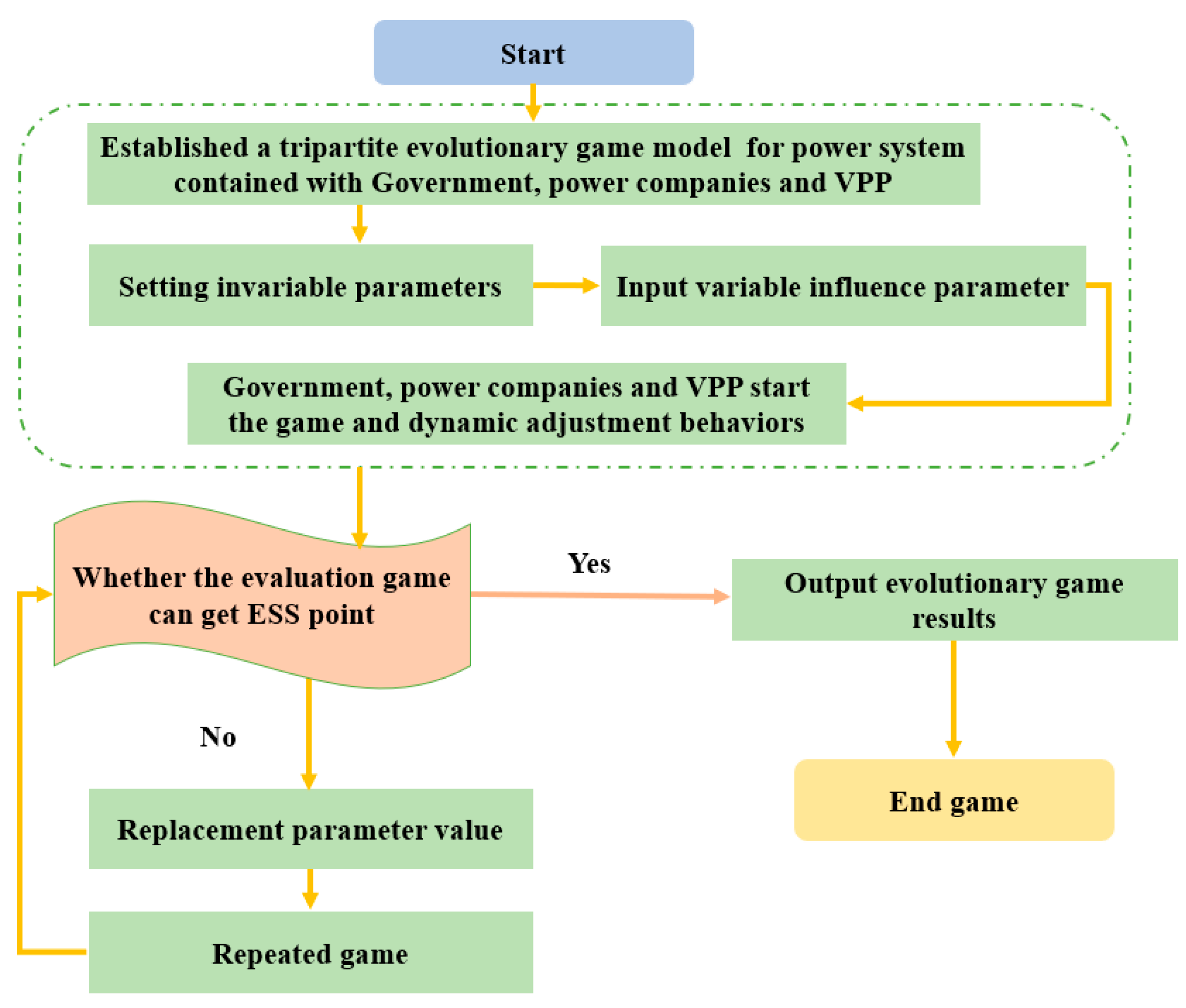

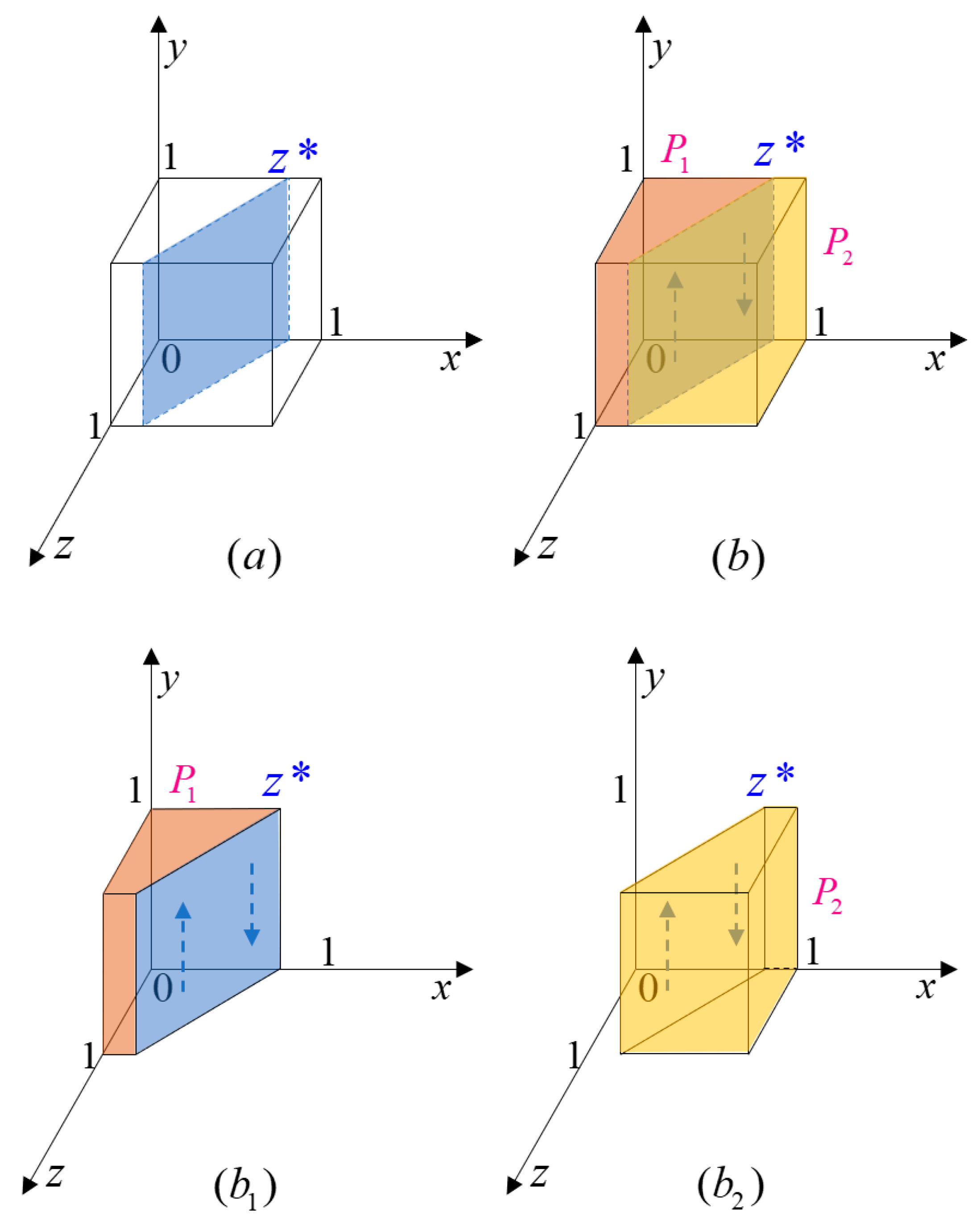

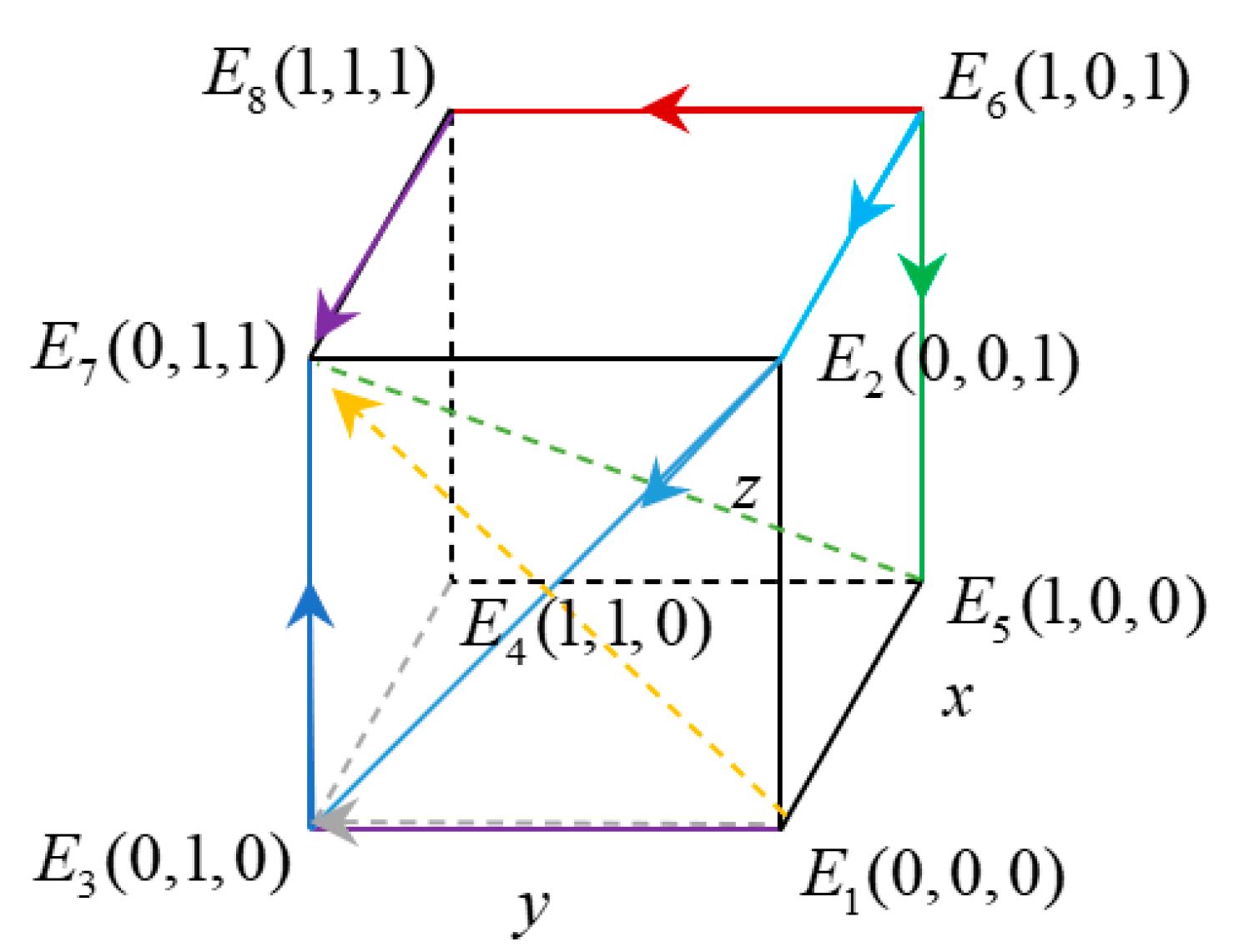
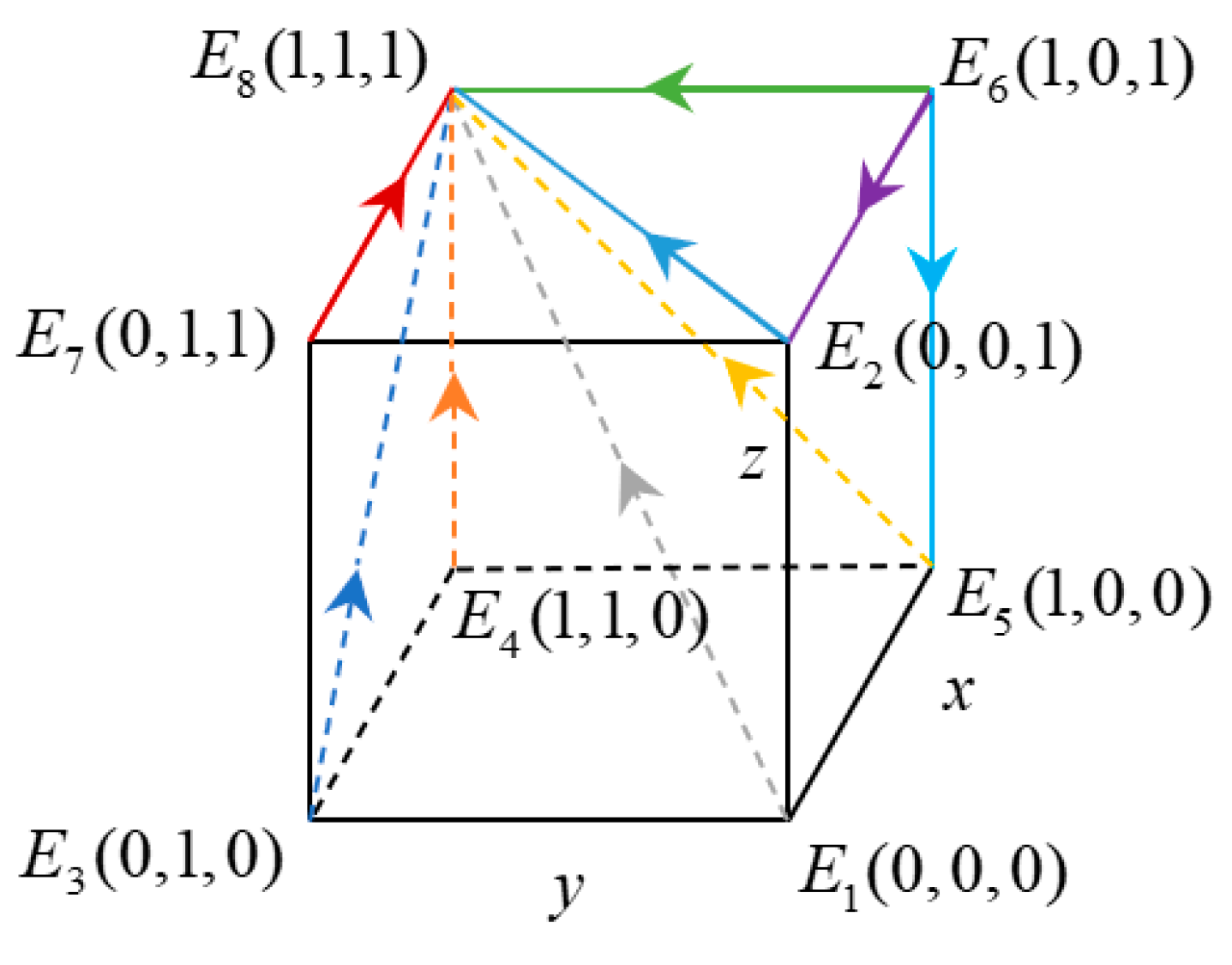
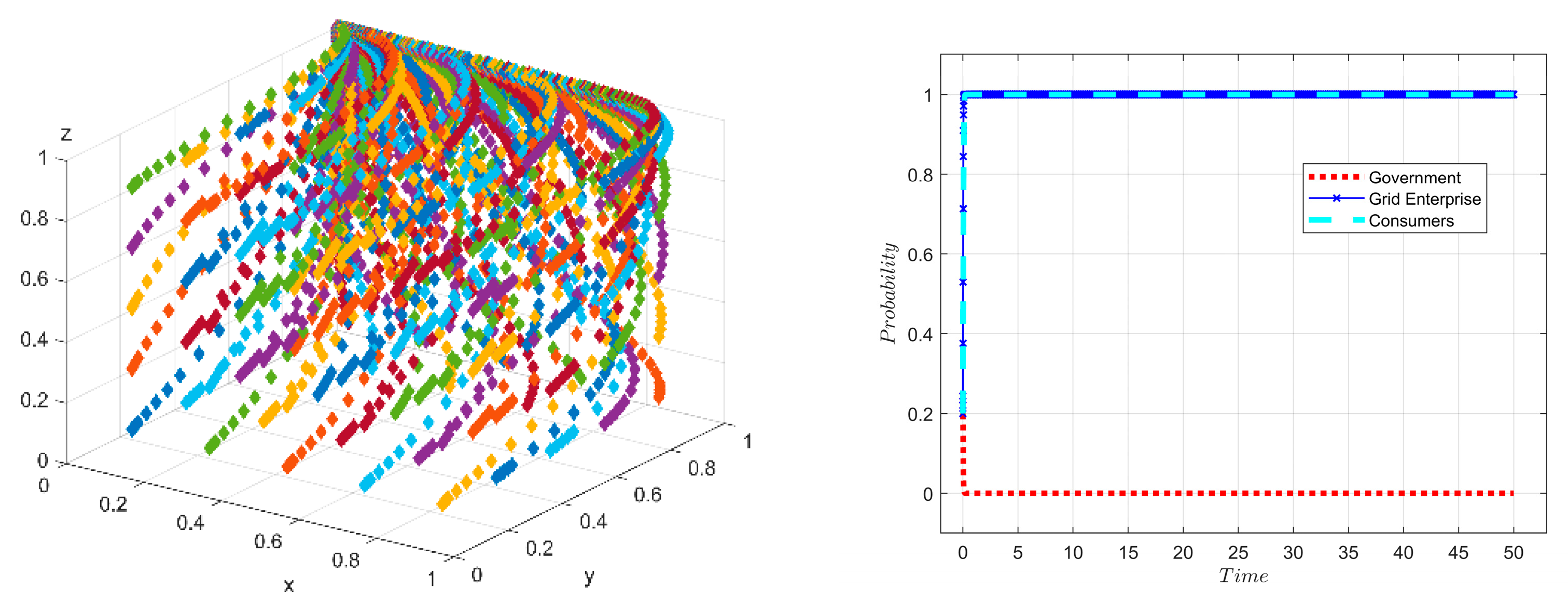
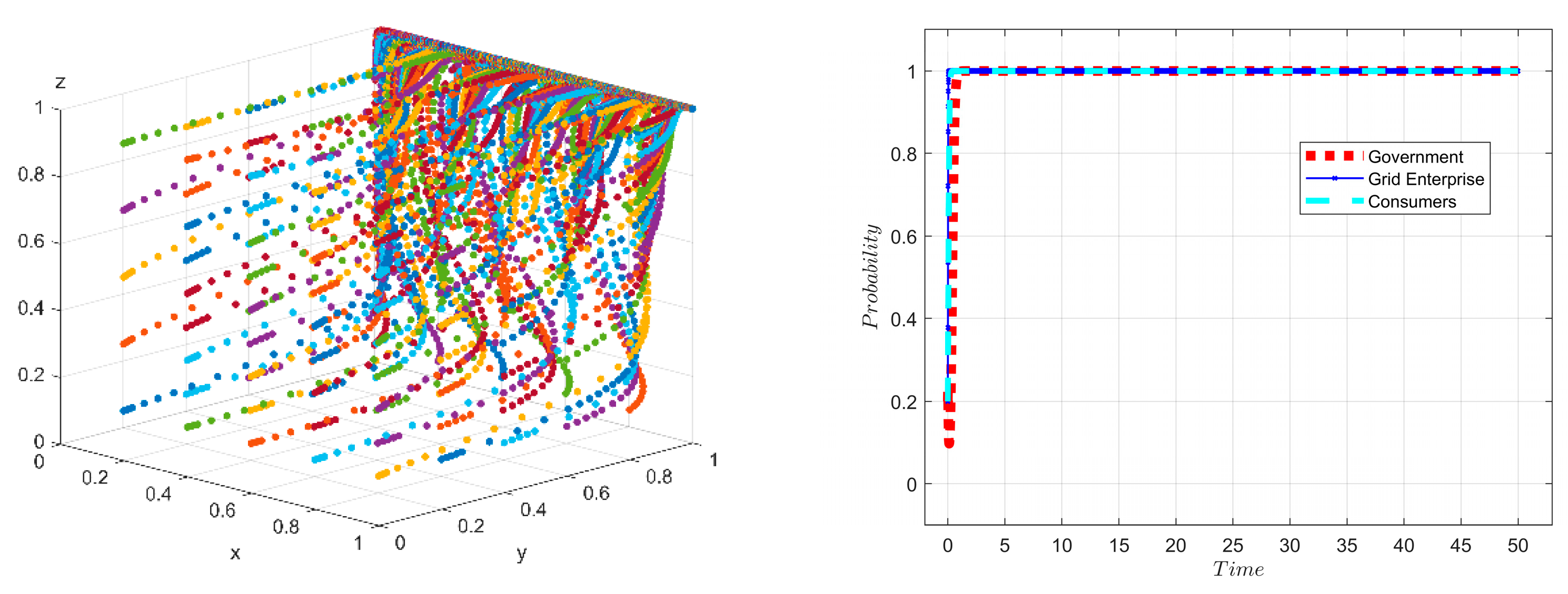
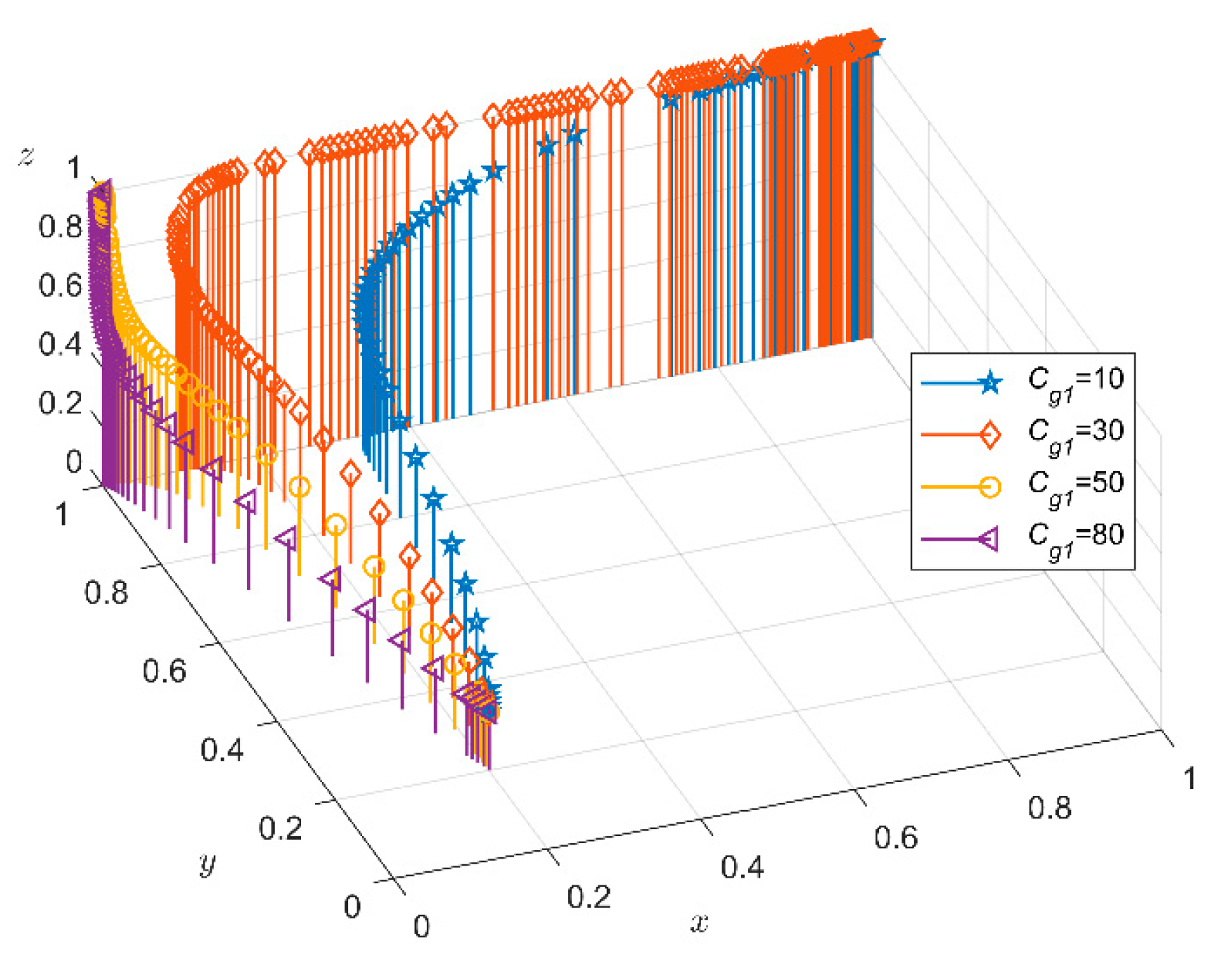

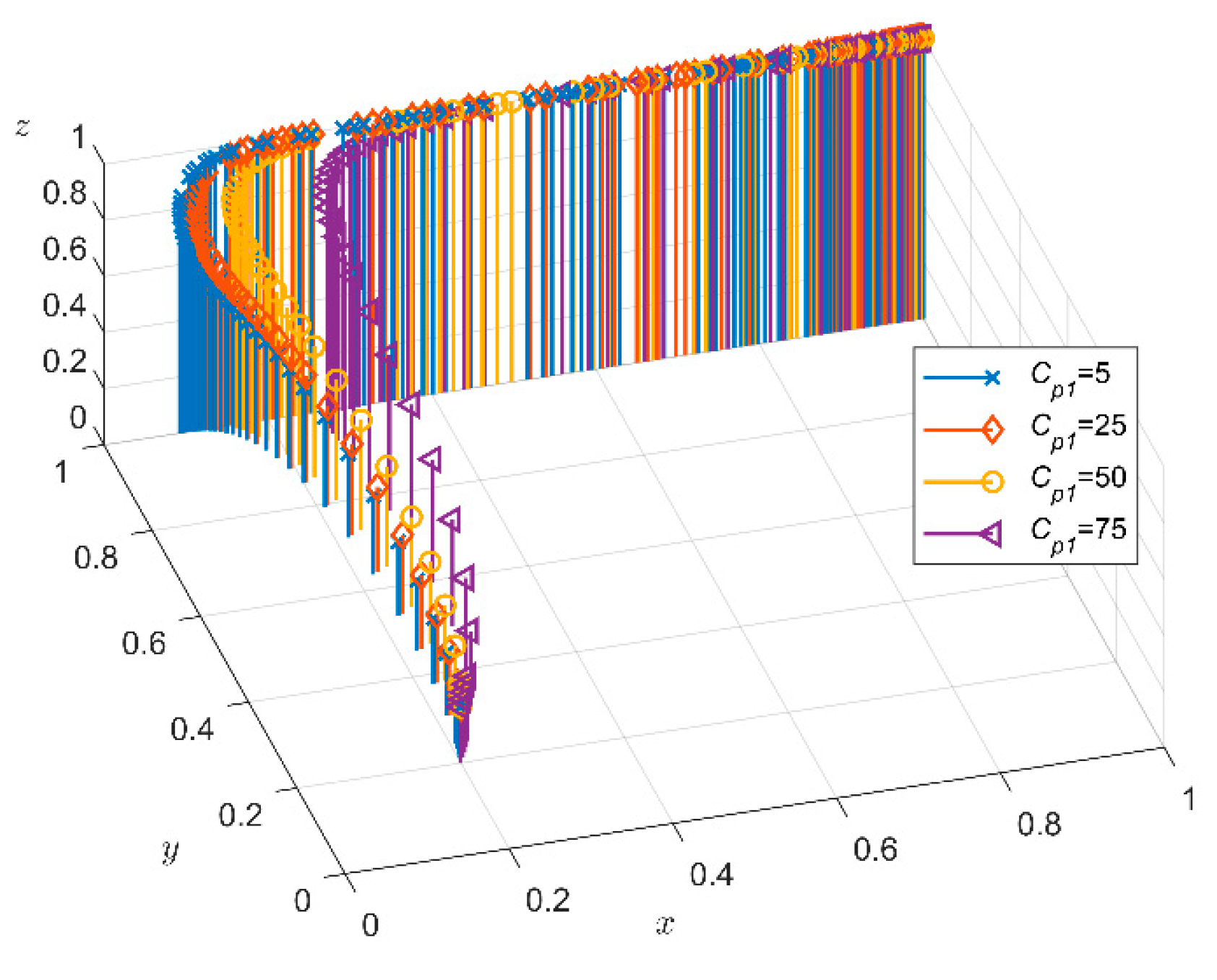
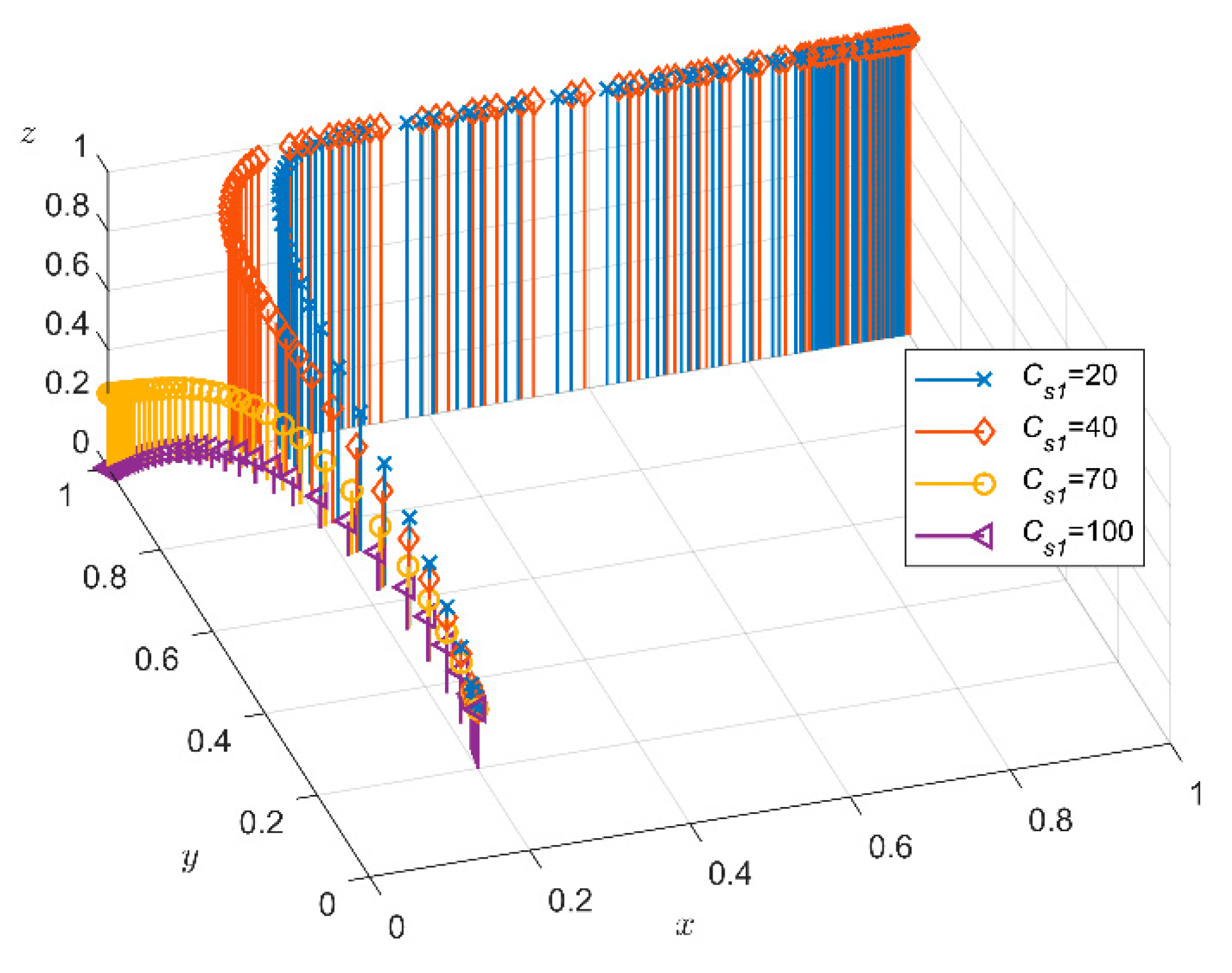
| Government | Power Companies | VPPs | |||
|---|---|---|---|---|---|
| Policy costs and initial benefits when the government chooses Strategy | Initial benefits and initial costs when power companies choose strategy | Initial benefit and initial cost strategies when VPPs choose strategy | |||
| Management costs when the government chooses Strategy | Additional costs for power companies when choosing strategy | Additional costs when VPP chooses Strategy | |||
| Benefits when both power companies and VPPs are actively involved in choosing and | Incremental benefits when the power companies’ choice strategy and VPP choice strategy emerge | Incremental benefits when the power companies’ choice strategy and VPP choice strategy emerge | |||
| Benefits when power companies choose and VPPs choose | Incremental benefits when power companies choose strategy and VPPs choose strategy | Incremental benefits when power companies’ choice strategy and VPP choice strategy emerge | |||
| Government penalties and incentives for power companies | Opportunity costs for power companies when choosing strategy | Government subsidies for VPP choice strategy | |||
| Government | Power Companies | VPP | |
|---|---|---|---|
| Equilibrium Points | Eigenvalue 1 | Eigenvalue 2 | Eigenvalue 3 |
|---|---|---|---|
| Scenario 1 | 50 | 60 | 50 | 30 | 30 | 30 | 60 | 30 | 80 | 80 | 60 | 50 |
| Scenario 2 | 30 | 60 | 50 | 10 | 10 | 10 | 60 | 30 | 80 | 80 | 60 | 50 |
Disclaimer/Publisher’s Note: The statements, opinions and data contained in all publications are solely those of the individual author(s) and contributor(s) and not of MDPI and/or the editor(s). MDPI and/or the editor(s) disclaim responsibility for any injury to people or property resulting from any ideas, methods, instructions or products referred to in the content. |
© 2023 by the authors. Licensee MDPI, Basel, Switzerland. This article is an open access article distributed under the terms and conditions of the Creative Commons Attribution (CC BY) license (https://creativecommons.org/licenses/by/4.0/).
Share and Cite
Zhou, J.; Chen, K.; Wang, W. A Power Evolution Game Model and Its Application Contained in Virtual Power Plants. Energies 2023, 16, 4373. https://doi.org/10.3390/en16114373
Zhou J, Chen K, Wang W. A Power Evolution Game Model and Its Application Contained in Virtual Power Plants. Energies. 2023; 16(11):4373. https://doi.org/10.3390/en16114373
Chicago/Turabian StyleZhou, Jinghong, Ke Chen, and Weidong Wang. 2023. "A Power Evolution Game Model and Its Application Contained in Virtual Power Plants" Energies 16, no. 11: 4373. https://doi.org/10.3390/en16114373
APA StyleZhou, J., Chen, K., & Wang, W. (2023). A Power Evolution Game Model and Its Application Contained in Virtual Power Plants. Energies, 16(11), 4373. https://doi.org/10.3390/en16114373





